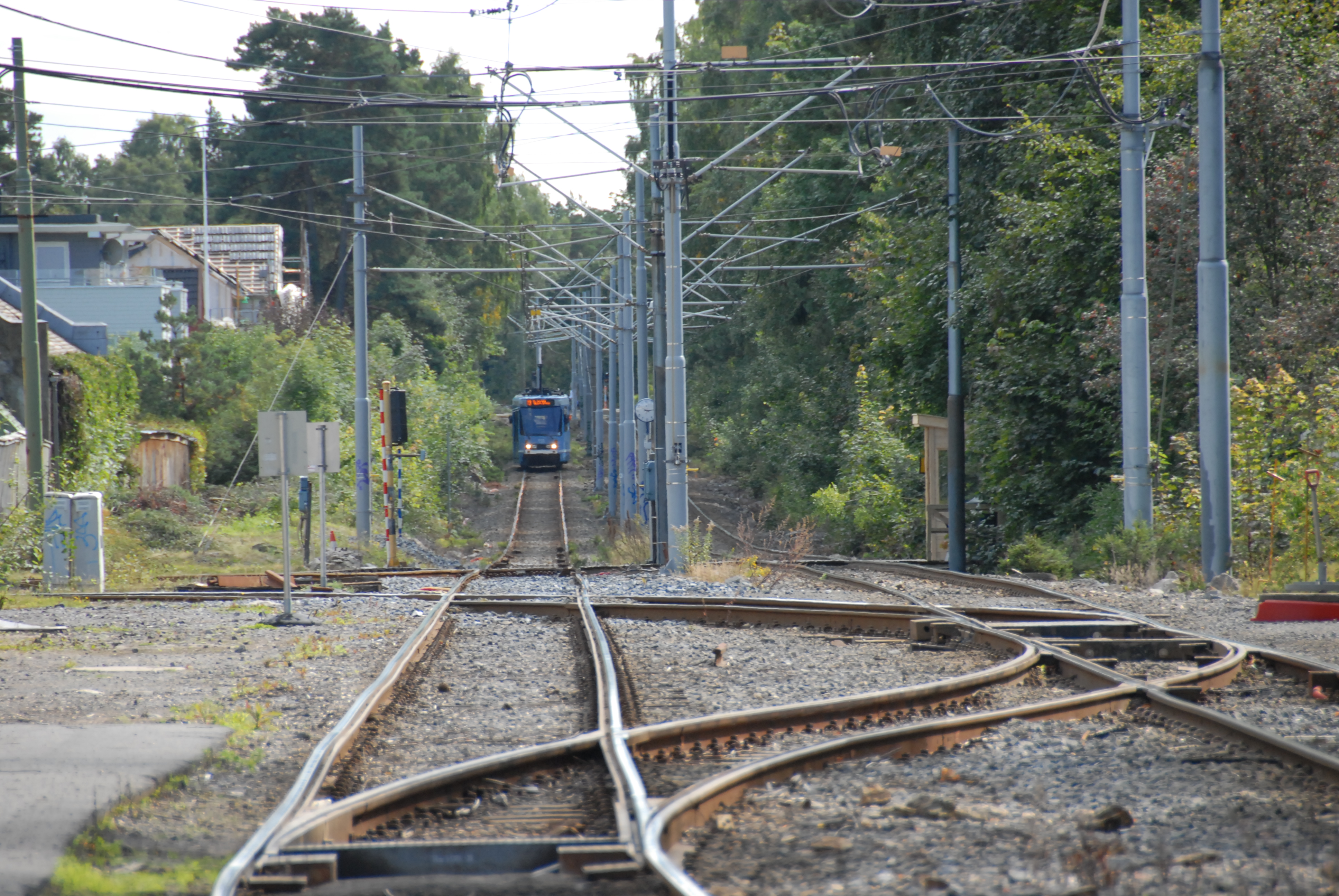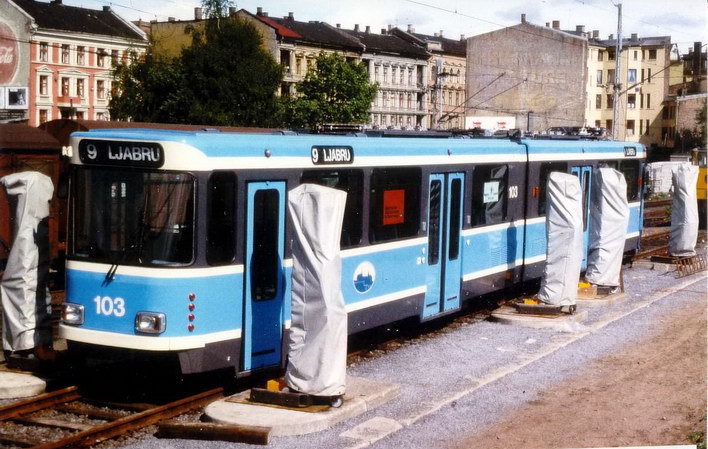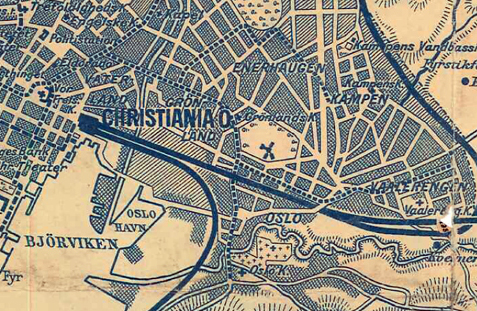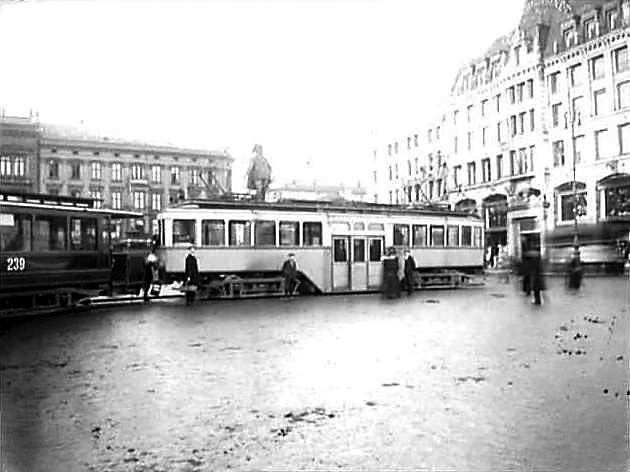|
Ekeberg Line
The Ekeberg Line ( no, Ekebergbanen) is a long light rail line of the Oslo Tramway which runs from Oslo Hospital tram stop, Oslo Hospital to Ljabru in Oslo, Norway. Operated by lines 13 and 19, it serves the area of Nordstrand, Norway, Nordstrand and the neighborhoods of Ekeberg, Jomfrubråten, Bekkelaget and Ljan. The line is operated by Oslo Sporvognsdrift using SL79 and SL95 trams on contract with Ruter. The line itself is owned by Sporveien. At Oslo Hospital (station), Oslo Hospital, the line connects to the Bjørvika Line, which runs to the city center. Proposals for a line in the area were first launched 1897, but not until 1914 were the necessary permits granted. The line was built and operated by Ekebergbanen (company), Ekebergbanen. The line opened in 1917, and connected to the Gamleby Line to reach Stortorvet (station), Stortorvet in the city center. The line differed from the street trams in that it ran in its own right of way and used 1,200 volt supply, unlike the 6 ... [...More Info...] [...Related Items...] OR: [Wikipedia] [Google] [Baidu] |
SL79
SL79 is a class of 40 articulated trams operated by the Oslo Tramway of Norway. The trams were a variation of the Duewag trams that had been developed by the German manufacturer since the 1950s. The six-axle vehicles are unidirectional with four doors on the right side. The trams can seat 77 passengers three and four abreast, with an additional 91 people able to stand. Power output is , provided by two motors on the two end bogies, that supplement a central unpowered Jacobs bogie located under the articulation. The trams are long and wide. They are capable of and have standard gauge. They were built in two series, the first of 25 units delivered in 1982–84, and the second of 15 units delivered in 1989–90. The first 10 units were built by Duewag, while the last 30 were built in Norway by Strømmen. They were numbered 101 through 140. The two series vary slightly in specifications. The trams were ordered in 1979 after the 1977 decision to not close the tramway, after the SM53 ... [...More Info...] [...Related Items...] OR: [Wikipedia] [Google] [Baidu] |
Ljabru
Ljabru is a hill and neighborhood in the borough of Nordstrand in Oslo, Norway. It is mainly a residential area with detached housing as well as larger blocks. It is served by the Ekeberg Line terminal station Ljabru. It is located south of Nordstrand, east of Ljan, west of Mortensrud and north of Hauketo. Toponymy The neighbourhood is named after an old farm – Old Norse ''Ljarnarbrú''. The first element is the genitive of an old rivername ''Ljǫrn'', the last element is ''brú'' 'bridge A bridge is a structure built to span a physical obstacle (such as a body of water, valley, road, or rail) without blocking the way underneath. It is constructed for the purpose of providing passage over the obstacle, which is usually somethi ...'. References Neighbourhoods of Oslo {{Oslo-geo-stub ... [...More Info...] [...Related Items...] OR: [Wikipedia] [Google] [Baidu] |
Gamlebyen Line
The Gamlebyen Line ( no, Gamlebylinjen) was a section of the Oslo Tramway which ran east from Jernbanetorget along Schweigaards gate (street), past the Bjørvika then turns south along Oslo gate, and past Gamlebyen before becoming the Ekeberg Line. The section was served by lines 18 and 19 before it was replaced by Bjørvika Line since October 2020. History The line was opened by Kristiania Sporveisselskab in 1875 as a horsecar route between Stortorvet and Gamlebyen. In 1900 the line was electrified, and received branch lines to Kampen and Vålerenga. The Vålerenga Line was extended to Etterstad in 1923, where there was a transfer to the Østensjø Line. Until 1925, the line was named the Oslo Line; with the name change of the city from Kristiania to Oslo, the district known as Oslo was renamed Gamlebyen. The plans from 1919 called for a common connection from the Østensjø Line and the Ekeberg Line to the city center, along with the proposed Lambertseter Line. The Ekberg Line ... [...More Info...] [...Related Items...] OR: [Wikipedia] [Google] [Baidu] |
Oslo Sporveier
AS Oslo Sporveier is a defunct municipal owned company responsible for public transport in Oslo, Norway. It was created in 1924 to take over the city's two private tram companies. In 1927 its started with bus transport, including from 1940 to 1968 trolleybuses. Since 1966 rapid transit and from 1985 water buses have also been operated by the company. It was split into two separate companies in 2006; Kollektivtransportproduksjon took over the operation while Oslo Public Transport Administration (who retained the Oslo Sporveier brand) was responsible for buying the services, fare regulation and marketing. The latter merged into Ruter in 2008, when the Oslo Sporveier brand was discontinued. History It all started with trams In 1875, Kristiania Sporveisselskab (KSS) started the first horsecar services in Oslo—at the time called Kristiania. It was followed by Kristiania Elektriske Sporvei (KES) who established electric tram services in 1894; by 1900 KSS had also converted its route ... [...More Info...] [...Related Items...] OR: [Wikipedia] [Google] [Baidu] |
Simensbråten Line
The Simensbråten Line ( no, Simensbråtenlinjen) was a light rail line of Oslo Tramway between Jomfrubråten and Simensbråten in Oslo, Norway. Opening on 30 September 1931, it branched off the Ekeberg Line at Jomfrubråten and had three stops along the route— Ekebergparken, Smedstua and Simensbråten. Operated by Ekebergbanen, the line was closed on 29 October 1967. It is the only light rail line in Oslo to have been closed. __TOC__ Route The Simensbråten Line was a long branch of the Ekeberg Line. It branched off south of Jomfrubråten and had three stations: Ekebergparken, Smedstua and Simensbråten. The line started at above mean sea level and terminated at above mean sea level. The line served the areas of Ekeberg and Simensbråten. In rush hour Ekebergbanen provided direct services to the city center, but otherwise only provided a shuttle service to Jomfrubråten. History In 1918, AS Ekebergbanen sent an application to build a funicular from Gamlebyen (then ... [...More Info...] [...Related Items...] OR: [Wikipedia] [Google] [Baidu] |
Stortorvet (station)
Stortorvet is a tram stop on the Oslo Tramway in Oslo, Norway. The station is located on the square Stortorvet in the city centre A city centre is the commercial, cultural and often the historical, political, and geographic heart of a city. The term "city centre" is primarily used in British English, and closely equivalent terms exist in other languages, such as "" in Fren .... It is served by the lines 17, 18 and 19. In 2009, it was decided to improve the square, the station and the tram tracks in the street. References Oslo Tramway stations in Oslo {{oslo-tram-stub ... [...More Info...] [...Related Items...] OR: [Wikipedia] [Google] [Baidu] |
Ekebergbanen (company)
AS Ekebergbanen was a private company that built and operated the Ekeberg Line in Oslo, Norway. It was founded 27 March 1914, and the line opened 11 June 1917 from Stortorvet to Sæter. The company also built a line to Simensbråten that was closed 29 October 1967. Ekebergbanen also operated buses in Oslo. History The company was founded on 24 March 1914, and started construction of the line immediately, but the delivery of technical equipment and rolling stock was delayed because of the First World War. The company's formal establishment was therefore made on 1 June 1917, when the line between Stortorvet and Sæter was opened. In 1918, AS Ekebergbanen sent an application to build a funicular from Gamlebyen (then called Oslo) to Ekebergplatået. The stations were mostly built with tiny wooden sheds in new baroque architectural style by the Norwegian architect Erik Glosimodt. On the station Holtet, a larger station building was constructed, also drawn by Erik Glosimodt. This ... [...More Info...] [...Related Items...] OR: [Wikipedia] [Google] [Baidu] |
Bjørvika Line
The Bjørvika Line is a tram line in Sentrum and Gamleby in Oslo. It opened as a rerouting of the Gamleby Line. The former route was closed down on the same day of this line's opening. It has two stops, Bjørvika and Middelalderparken. It runs along Dronning Eufemias gate and Bispegata, instead of through Schweigaards gate and Munkegata. It is served by lines 13 and 19. Line 13 operates between Bekkestua and Ljabru, while Line 19 operates between Majorstuen and Ljabru. The section in Dronning Eufemias gate was constructed in the early 2010s, but the section between Bjørvika and Oslo Hospital, was only completed in 2021. The reason for this is the construction of the Follo Line project. Route It starts from Dronningens gate tram stop, through Prinsens gate and past the Bjørvika Public Library. It goes along Dronning Eufemias gate until it stops at Bjørvika. Afterwards, it follows down Dronning Eufemias gate through Bispegata before heading to Middelalderparken. From Middelal ... [...More Info...] [...Related Items...] OR: [Wikipedia] [Google] [Baidu] |
Ruter
Ruter AS is the public transport authority for Oslo and Akershus counties in Norway. Formally a limited company – 60% of its shares are owned by the Oslo county municipality and 40% by that of Akershus – it is responsible for the administration, funding, and marketing (but not direct operation) of public transport in the two counties, including buses, the Oslo Metro (''T-banen i Oslo''), Oslo Trams (''Trikken i Oslo''), and ferry services. Ruter also holds agreements with Norwegian State Railways concerning the regulation of fares on local and regional train services operated within the two counties. Operation The operation of services is performed by other companies: *Bus routes are subject to public service obligation, and operators include UniBuss, Nettbuss, Norgesbuss, Schau's Buss, and Nobina Norge. *The metro system is operated by Sporveien T-banen while the tramway is operated by Sporveien Trikken, both subsidiaries of the municipally owned Sporveien Oslo A ... [...More Info...] [...Related Items...] OR: [Wikipedia] [Google] [Baidu] |
Oslo Sporvognsdrift
Sporveien Trikken AS, formerly Oslo Sporvognsdrift AS and Oslotrikken AS, is the company that operates the Oslo Tramway in Oslo, Norway. Sporveien Trikken is owned by Sporveien, which is again owned by the city council and has an operating contract with Ruter. The company operates 72 trams (40 SL79 and 32 SL95), has 374 employees and headquarters at Grefsen. The company was led by the former Minister of Transport A ministry of transport or transportation is a ministry responsible for transportation within a country. It usually is administered by the ''minister for transport''. The term is also sometimes applied to the departments or other government a ..., Torild Skogsholm, until March 2011. References Railway companies of Norway Companies based in Oslo Oslo Sporveier Oslo Tramway operators {{norway-tram-stub ... [...More Info...] [...Related Items...] OR: [Wikipedia] [Google] [Baidu] |
Ljan
Ljan () is a residential neighborhood in the borough Nordstrand in Oslo, Norway. It is located in the eastern rolling hillsides of the fjord Bunnefjorden. To the south Ljanselva which begins at Lutvann has its mouth, and where it runs through Liadalen at Ljan it also constitutes the border with borough Søndre Nordstrand. The number of inhabitants was about 3,500 in 2004. Ljan Church is known as one of the very few churches in Norway that was built in the 1930s in the Romanesque Revival style. The public beaches at Ljan are Hvervenbukta, Ljansbadet and Katten, and in addition there are a number of private bath houses along Mosseveien. The borders to the north and east are less obvious and drawn between the school circuits Ljan and Nordstrand. The name originates with an Old Norse river name ' but the meaning has been lost to time. The old Ljan farms Originally Ljan was an old farm first written about in 1308. After 1650 it was partitioned in three, ( en, Upper Ljan), ( en ... [...More Info...] [...Related Items...] OR: [Wikipedia] [Google] [Baidu] |
Bekkelaget
Bekkelaget is a neighborhood in the borough Nordstrand in Oslo, Norway. Originally, Bekkelaget was the maritime area south of Oslo city, in Aker municipality adjacent to the Bunnefjorden. With the opening of the Østfold Line, Bekkelaget station was opened, and the elevated area between Ekeberg and Nordstrand was built up and more densely populated. This area was called Bekkelagshøgda, while the maritime area became known as Nedre Bekkelaget. This area is separated by Ormsund with Ormøya. Until 2004 Bekkelaget and adjacent Ekeberg constituted its own borough, ''Ekeberg-Bekkelaget''. Bekkelaget is known nationwide for the sports club Bækkelagets SK. The local rowing club is Ormsund RK Ormsund Roklub is a rowing club from Oslo, Norway. Established on 21 July 1883, it is based on Malmøya in the Oslofjord The Oslofjord (, ; en, Oslo Fjord) is an inlet in the south-east of Norway, stretching from an imaginary line between t .... See also * 1953 Bekkelaget landslide Ref ... [...More Info...] [...Related Items...] OR: [Wikipedia] [Google] [Baidu] |





